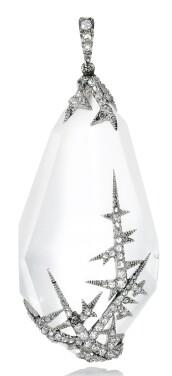Featured Lots by Alma Pihl
Alma Pihl Biography
Moscow-born Alma Pihl was one of the most exceptional designers employed by Fabergé. Unlike the firm’s other predominantly male workmasters who had extensive training and experience, this young woman was largely self-taught. It is unsurprising that, as the granddaughter of the renowned Fabergé master August Holmström and daughter of the master goldsmith Knut Oscar Pihl, Alma Pihl entered the world of jewellery design. However, her talent for design was truly unique.
Upon the death of her father, Pihl’s family relocated to St Petersburg. Here, she attended Carl Fabergé’s alma mater, the Annenschule, where she received private lessons in pattern-drawing from the Swedish Eugen Jakobson (1877-1940), also an artist for Fabergé. At the age of twenty, Pihl entered her uncle Albert Holmström’s workshop, where designers were required to draw meticulously detailed, life-size designs. In January of 1911, Pihl’s career was propelled forward by a request from Dr Emanuel Nobel for forty jewellery pieces by Fabergé. Sitting at her desk by the window in the workshop, Pihl was captivated by the way in which the sunlight glittered through the frost on the window, as if it were a ‘garden of exquisite frozen flowers’ - this vision inspired six brooch designs (U. Tillander-Godenhielm, Fabergé: his masters and artisans, Unicorn, 2018, p. 153). Thoroughly impressed with Pihl’s abrupt departure from Fabergé’s typical Neoclassical and Rococo designs, the workshop ordered six or seven of each design to be made. Dr Emanuel Nobel was equally mesmerised by the beautiful rendering of the frost; he bought the rights to the concept and subsequently ordered numerous other pieces conforming to Pihl’s design idea.
One of Pihl’s most significant commissions was the 1913 Winter-themed Imperial Easter Egg, for which Dr Emanuel Nobel temporarily waived his rights to the frost design concept. Pihl’s egg was influenced by the Spring reawakening of nature - poignantly coinciding with the Easter theme of resurrection and the changing landscape of Northern Europe as it emerges from the melting Winter snow. The following year Pihl was again selected to design the Imperial Easter Egg. This time, Pihl’s inspiration came from her mother-in-law’s decorative petit point embroidery work, a fitting idea given that the Empress Alexandra Feodorovna, for whom this egg was intended as a gift, was also known to enjoy embroidering.
By 1915, Pihl wanted to diversify her style. Ever the innovator, her work after this point employed elements of Art Nouveau, Art Deco and Modernist design. Sadly, the start of the Russian Revolution interrupted Pihl’s career. Fabergé was forced to close, and Pihl undertook a new career teaching German in St Petersburg and later drawing and calligraphy in Finland. Though she rarely discussed her work as a jewellery designer in the latter half of her life, today she is celebrated as a unique treasure in the masterful world of Fabergé.


